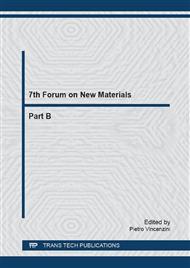p.32
p.38
p.44
p.54
p.64
p.70
p.75
p.82
p.93
Luminescence Properties of Ytterbium Activated PLZT Ceramics
Abstract:
In the present work the influence of co-doping with ytterbium ions (for 0, 0.5, 1.5, 2.5 wt.% of Yb3+) on physical properties of 8/65/35 PLZT was studied. The ceramic powders were synthesized by the modified sol-gel method, and underwent consolidation by the pressure-less sintering techniques, in Ts=1200°C/6h. Our investigations give a detailed account of the relationships between concentrations of trivalent ytterbium ions in PLZT matrix, on their structure, microstructure, as well as luminescence properties. Near-infrared luminescence spectra at about 1020 nm were registered, which correspond to 2F5/2 - 2F7/2 transition of Yb3+. Based on decay measurements, the luminescence lifetimes for the 2F5/2 excited state of Yb3+ were determined. Luminescence decay analysis indicates that the 2F5/2 lifetime increase with increasing activator concentration (Yb3+) in PLZT ceramic matrix.
Info:
Periodical:
Pages:
64-69
Citation:
Online since:
October 2016
Authors:
Keywords:
Price:
Сopyright:
© 2017 Trans Tech Publications Ltd. All Rights Reserved
Share:
Citation:


